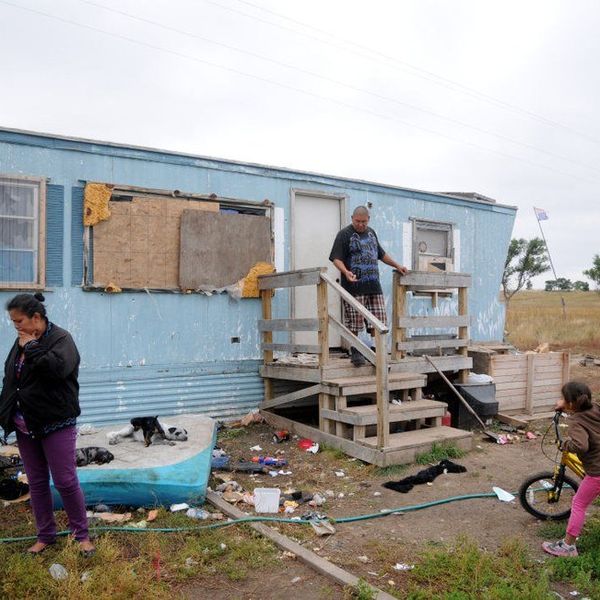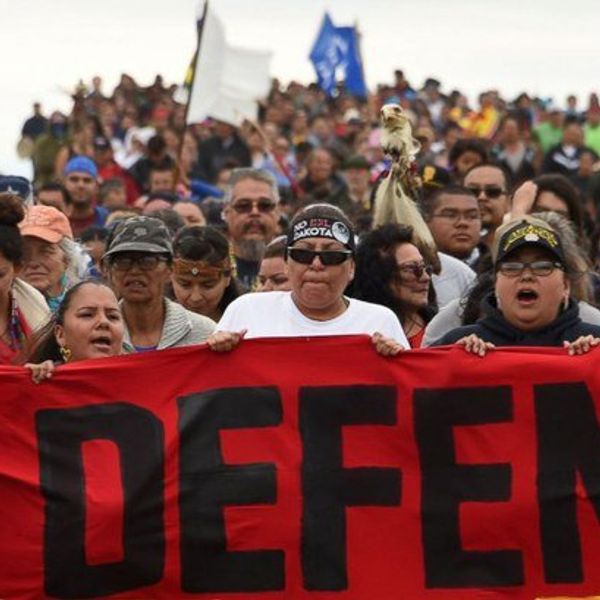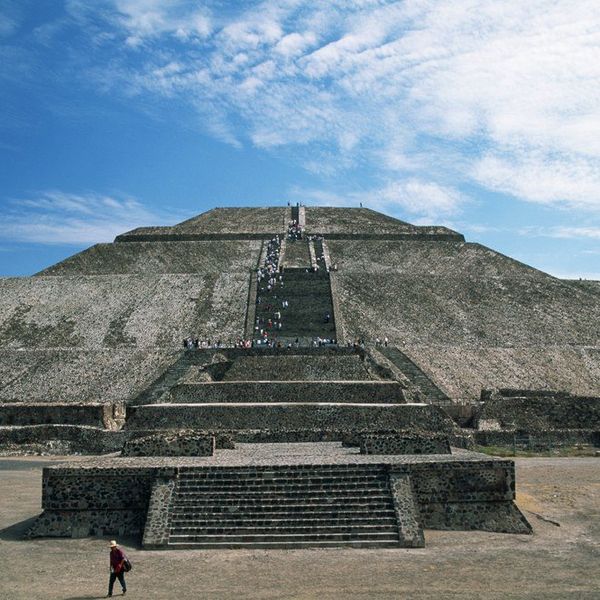With a history so steeped in bloodshed, corporate America seems to just be falling in line with the national pastime: ignoring the rights of people of color. Energy Transfer is an energy company that has planned to build a pipeline from North Dakota all the way down to Illinois. The Standing Rock Sioux are a Native American nation that are protesting the construction of this massive pipeline. These protests have been disturbingly glossed over by the mainstream media and the facts have been blissfully ignored. The Standing Rock Sioux tribe holds that the pipeline threatens their main source of water (the Missouri River), will desecrate even more sacred land, and ultimately violates the 1868 Ft. Laramie Treaty.
To start off, it is important to understand the environmental threat that this pipeline poses. The pipeline has already been rerouted three times because it has posed a very serious threat to surrounding water systems. In her article on Wired.com, Marley Walker goes into detail about the impossibility of the pipeline not going through a water system. “The pipeline has to cross water at some point, and wherever it does, it is—like all oil-moving operations—likely going to put another community’s water at risk.” She goes on to say that oil pipelines are actually the safest way to transport crude oil when compared to trucks or trains. And while that may be statistically true, the possible damage that could be done to the environment is still very high. The biggest issue is that the oil being extracted from the Bakken oil fields is a light crude oil. This means that it is less viscous and dense. This light crude oil would easily move around in a water system and could be easily soaked up into the groundwater. Clean-up would be exponentially more difficult because the oil would easily traverse miles before it could be quarantined. While the US Army Corps of Engineers has indeed revised the pipeline’s path three times, Walker points out that “any pipeline crossing will impact some water supply somewhere.”
Threatening water supplies didn’t seem to stop Energy Transfer. But what about desecrating Native American sacred lands? The construction of the DAPL was done with very minimal Standing Rock Sioux involvement. According to a Robinson Meyer article in The Atlantic, “whenever a federal agency undertakes or approves a construction project, it must consult with local Native nations or tribes about whether sacred sites or places are nearby.” This is done to ensure that any sacred sites aren’t accidentally destroyed. But the Sioux have alleged that the US Army Corps of Engineers did no such thing. They claim that it was only until the pipeline construction was almost approved that they sought the counsel of the tribe. Sadly, claims that the Dakota Access company was building on sacred burial sites didn’t stop construction. In fact, “less than 24 hours after evidence of the new sacred sites were provided to the court, the Dakota Access company began construction on those same exact sites, perhaps destroying many of them forever.” Because of the desire to finish the pipeline so quickly, Energy Transfer has joined ISIS as deliberate destroyers of historical relics. The sacred lands, the lands where these people laid to rest their leaders and families, were upturned without a second thought. “The committee that oversees historic preservation on behalf of Congress explicitly decrees that ‘regulations require Federal agencies to consult with Indian tribes when they attach religious and cultural significance to a historic property regardless of the location of that property.’” The Dakota Access company seemingly did next to nothing to ensure that these federal rules and regulations were followed. What’s even more tragic is that the relics that were destroyed can’t even be recovered because they were most likely collected up as debris.
Another strong claim against the DAPL is that they have violated a federal treaty. The 1868 Ft. Laramie Treaty was born out of the violent clashing between the Sioux and Whites in the Dakota Territory. It gave the Sioux sovereignty and claim to the Black Hills of Dakota. After an expedition led by Gen. Custer in 1874 found that there was gold in that land, White miners began setting up shop in what was legally Sioux land. The Sioux faced off with his men at the Battle of Little Bighorn, where Custer and all his men were killed in 1876. The US government reacted by sending a larger force and confiscated back the land that originally belonged to the Sioux in 1877.
The Sioux Nation enjoyed relative peace on their land for a mere six years. Then after it was discovered that that land was rich in a certain resource, the government stepped in and took it away. And that dispute is still being played out today. The Sioux feel that their land was stolen. Not only was it stolen in the sense that a White scourge moved in and displaced them, confined them into pockets of land, and then ignored them. Now the foreign invaders were violating the very same treaty they themselves had drafted. And while the land has remained in the government’s control, the treaty is still a valid legal document. This is the argument of the water protectors. They are stating that that treaty is still a valid document, and if that is the case, then the lands that the Dakota Access company wants to build on is their land. And if they violate that treaty, then they are violating federal law. But what is ironic is that Energy Transfer continued construction despite the ongoing legal investigation as to whether they had a right to build on Sioux land. Yet these people are not being charged with anything.
It has become common practice to see protesters be declared threats to law enforcement who in fact are just angry that their rights are being violated. The Morton County Sheriff’s Dept. has arrested over 500 peaceful protesters since the protests began. There have been barricades erected to block off entire highways and even riverbeds so that protesters would not have the opportunity to “harm” them. Thanks to the brave reporting by Amy Goodman from Democracy Now!, we have seen the extent to which the Dakota Access company will go to protect its financial interests. They hired a private security company early September which used attack dogs to intimidate, and then actually attack the peaceful protesters. There is video evidence all over the internet of police officers just pepper-spraying away at a group of protesters who were lined up at a river bed. Police officers have also used water cannons against protesters at night in near freezing temperatures to hold them back, without caring that their actions could cause hypothermia, and possibly worse. Interviews with nation leaders at the frontlines have even reported that the Morton County Police Department took violent action against protesters because they overheard that the Sioux were making pipe bombs. The egregious “misunderstanding” was enough to mobilize law enforcement, but there was no comment when it was discovered that the Sioux were actually talking about smoking their ceremonial pipes.
Misunderstandings aside, this entire conflict has sparked much-needed debate about the US government’s responsibility to the indigenous population, what exactly the mainstream media finds “newsworthy,” and how much freedom is actually allotted to the press. In a study that dealt with food environments for indigenous Americans, Chodur et al. found that the native population was extremely riddled with diabetes and obesity. Not only that, but American Indians living on reservations are more likely to live in areas where fresh produce is overpriced, while surrounding fast-food restaurants offer cheap alternatives. Many American Indians depend on the land to sustain themselves, but their natural resources, especially water, is usually tapped by local governments for their own use. Also, tribal lands are usually located in areas where the infrastructure is lacking at best, making it hard for regular means of transportation to reach the reservation. This makes the possibility of importing produce from the surrounding areas that much more difficult and costly. This lack of infrastructure has created “food deserts,” and the health of the overall indigenous population is definitely feeling it. But setting up conditions that create a health crisis among a large group of people is not the only way the government has neglected the indigenous population.
Rachel E. Luft conducted a study on how the US government interacted with the leadership of indigenous nations during huge natural disasters. Up until 1998, there was no official liaison between the federal government’s disaster relief programs and American Indian Groups. The Stafford Act that was implemented by FEMA “only identifies that the governor of a State or territory can request a declaration of a disaster from the President of the United States.” What this meant was that when a natural disaster occurred, the federal government disbursed aid funding to the state governments. The state government would then allocate funds to give to the tribal leadership. This protocol made it extremely clear that the US government did not recognize the sovereignty of the indigenous nations. President Obama later signed legislation in 2013 that allowed tribal nations to receive disaster relief funds directly from the federal government. But policy only helps so far. Luft breaks down the horrid disaster caused by the Ash Creek fire in 2012. The reservation suffered greatly from a lack of reliable infrastructure. There are no cell towers on the reservation, making mobile communication impossible. The reservation itself is huge and people have to drive long distances on dirt roads to get to their neighbors. The only form of communication was through landline phones, which made it difficult to relay any emergency information if the person wasn’t home. The Northern Cheyenne living on the reservation also had internet, but it relied on a very weak and faulty electrical grid. The reservation itself lacked the emergency vehicles necessary to fight fires. With disaster funding from the federal government not being secured until the following year, the reservation had to rely on a few fire trucks and one helicopter which were in subpar condition. The issue is even more complicated once one takes into account the process of dividing up funds, and who is responsible for paying for the reconstruction of certain things like roads, or communications grids.
All these issues ultimately boil down to sovereignty. Brian Delay analyzed years of works that cited US-tribal relations and found that, unsurprisingly, Native Americans are portrayed as asterisks in the history of this country. When talking about the westward expansion, Manifest Destiny, or when dealing with the massive genocide of Native Americans, those topics are downplayed and American patriotism is used as propaganda to distract from the grim reality. The American government became an empire within the North American continent. Historians, cites Delay, calculate that native populations controlled 80% of the land at the time the 13 colonies signed the Declaration of Independence. By 1898, just over 100 years, the indigenous population was cut down by about 75%, and they controlled only 4% of the land. It is unsurprising then to understand the sheer anger and resentment the native population of this bloodthirsty country feels. It is an unrecognized genocide. It is a history of displacement. It is a history of being boxed into almost unusable plots of land. It is the stripping away of any rights or treaties the benevolent government drafted to give them legal protections. It is a history of putting economic progress first over the welfare of these peoples.
The water protectors protesting the completion of the Dakota Access Pipeline are a refreshing breath of air. Their peaceful protest has had a very clear objective: protect their water supply and the sanctity of their lands. The lack of media coverage on these protests is only a testament of the incongruities between what people feel is important, and what large media corporations feel is important. Reporters like Amy Goodman, Cenk Uygur from The Young Turks, and even RT, have spoken out against the illegal activities of Energy Transfer and the Morton County Police Department. They have strived to report on the constant day-to-day battles happening on the frontlines. But they are relatively small media outlets that are already marked as biased news sources, such as Counter Current News. This isn’t by accident. Big corporations like Energy Transfer and Sunoco Logistics work hand in hand with media outlets through their public relations departments. They are masters at minimizing the extent of their crimes, while also casting doubt on the actual protesters. They are able to frame the situation in such a way that a relatively uninformed viewer would believe that the protesters were inciting violence, and were only composed of hooligans looking to cause trouble. This can’t be farther from the truth. But the company’s interests are contingent on public perception and so they help coordinate a propaganda campaign against the protesters crying that there are bomb threats and other imaginary acts of aggression. Yet the companies aren’t only targeting protesters.
Amy Goodman of Democracy Now! had an arrest warrant issued against her after she covered the clash between the protesters and the private security guards that used dogs to attack them. She was charged with criminal trespass. When that didn’t work, she was charged for inciting a riot, but that was later rejected by a judge, and all charges against her were dropped. A leading organizer for the protests, Cody Hall, was arrested and held without bail for the same misdemeanor of trespassing. These legal actions against people exercising their right to a free press and the right to peaceably assemble was clearly infringed upon. These actions prove the power and influence these corporations exert over government agencies. When Goodman’s footage of the dog attacks on the protesters went viral, that’s when Energy Transfer knew it was time to step in. They fabricated false and unfounded charges on a reporter who was showing the world the truth about what was really going on.
As of today, the Army Corps of Engineers has ordered that construction be halted so that it can be rerouted around the Standing Rock Sioux land. This declaration has been received as a victory by the water protectors. Their months of protest have culminated in the pipeline being rerouted. But the issue will still remain: the pipeline must still cross the Missouri River, and when it does, it will create a potentially dangerous situation for anyone downstream. This small victory should be taken lightly, as Energy Transfer has already ignored any legal proceedings or declarations telling it to stop construction. They had already ignored a stop and ended up desecrating sacred burial sites of the Sioux tribe. And there is no indication that they will honor this one. The Dakota Access company put out a statement reiterating that they were still very willing to complete construction of the pipeline and get it done quickly. They cited that the Army Corps of Engineers has repeatedly stated that they had abided by all relevant laws when it came to them working on the pipeline. These are the words of a determined entity, and they aren’t meant to be taken lightly.
This entire protest has shed a light on a dark part of America’s history. The constant struggle between the usurpers of this land and those who were at the mercy of the White man is a microcosm of modern-day colonialism. This relatively small and localized protest is being played out in the Global South. It is descended from movements like that of Chico Mendes in Brazil. It emulates the desire for sovereignty the world saw when India sought to kick out their British oppressors. It has a smell similar to the liberation movement in the Congo where a brave, honest, and noble man, Patrice Lumumba, sought complete autonomy at the cost of his life. This protest is a remnant of the horrid past, and it is forcing people to find solutions to complicated questions. The Standing Rock Sioux are fighting their fight along with 199 separate tribes who are supporting them in solidarity. We have a duty, as outlined in the UN Declaration of Human Rights, to the community in which alone the free and full development of his personality is possible. We must stand in solidarity with those who have been stripped of their voice. We must stand with those who are being ignored. We must stand with those who are just seeking to live a happy life. It is OUR duty.





















